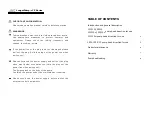
25
MKIV Ocean Unit 1
Backstay Adjusters
Backstay adjusters allow headstay tension to be varied to change sail shape to
match conditions. They permit a very tight headstay to be eased when boat is not
in use. For best performance, consider adding a backstay adjuster; either a block
and tackle, a mechanical adjuster like those offered by Harken, or a hydraulic adjuster.
Remember to keep headstay tight for best performance when furling or reefing.
If your boat is fitted with an adjuster be sure that it is tensioned
before
the halyard
is tensioned. If not, backstay adjuster may increase halyard tension and could
damage the sail or furling system.
Racing boats often slack the headstay completely when sailing downwind. Check
to be sure that foil does not jam against upper headstay terminal when backstay
is released. To prevent this, it may be necessary to shorten foil slightly.
On many boats it will not be possible to attach
spinnaker halyard to bow pulpit or it may be
"sucked" into jib when furling.
On some boats the spinnaker halyard lays across
headstay and will catch on halyard swivel, foils or
jib halyard. To prevent problems it may be necessary
to install a masthead bail to move spinnaker halyard
block forward and to one side.
Boats with external halyards may find it necessary to
flip both ends of spinnaker halyard behind spreaders
to prevent fouling with furling system.
Headstay Tension
A furling system will work best if headstay is tight.
A loose headstay is difficult to rotate and can cause
unusual wear on foil joints.
To adjust headstay tension, remove sail and furling line
from unit and follow instructions on page 21.
Tip: Before adjusting headstay tension, slack
mainsheet and vang.
Spinnaker Halyards
Spinnaker halyards occasionally cause problems
with furling.
WARNING! In severe cases, spinnaker
halyards can jam furler causing loss of
control of boat. Make sure halyards are
clear of top of foils and halyard swivel.
Crosspin
Commissioning
Spinnaker Halyards/Headstay and Backstay Tension








































